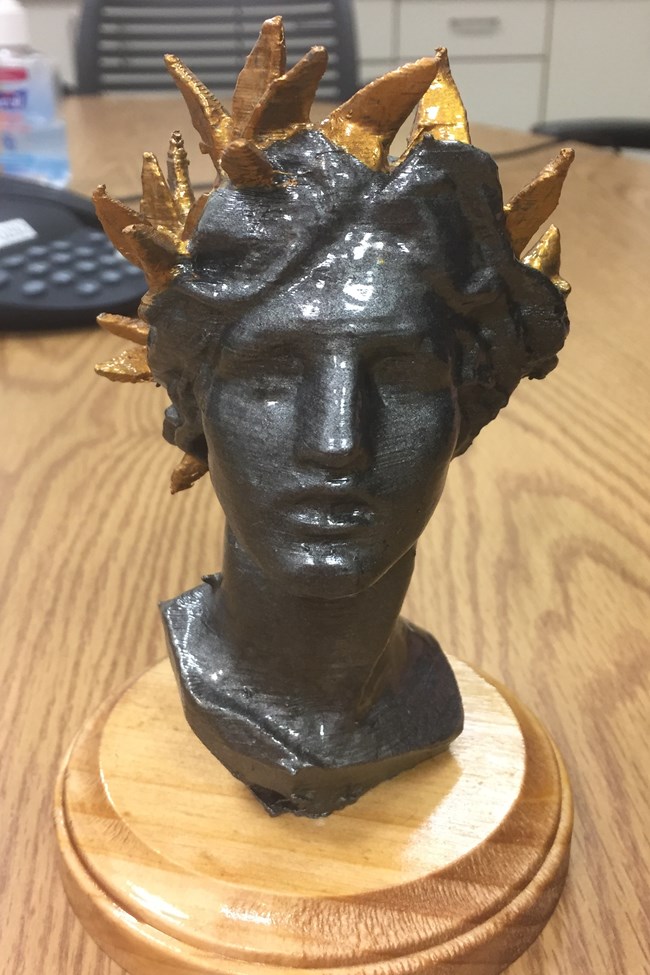Last updated: July 8, 2023
Article
Partnership With Medical Center Reveals Sculptor’s Century-Old Mysteries

Department of Diagnostic Radiology at Dartmouth-Hitchcock Medical Center
More than a century ago, sculptor Augustus Saint-Gaudens and his assistants created two dozen artistic mysteries with a few dabs of plaster. Through the years, the identities of many of these sealed sculpture molds had been lost. Until now.
Saint-Gaudens and his assistants sealed shut roughly two dozen sculpture molds, which they placed into storage for safekeeping. Since then, the molds have passed from the Saint-Gaudens family to the non-profit Saint-Gaudens Memorial. They survived a catastrophic studio fire in 1944. Now they are part of the collections at Saint-Gaudens National Historic Site, which preserves the sculptor’s home and studio in Cornish, New Hampshire.
The molds remain sealed but, thanks to an innovative partnership with the Department of Diagnostic Radiology at Dartmouth-Hitchcock Medical Center in Lebanon, New Hampshire, their secrets have been revealed. Using computed tomography (CT) scanning, normally used for creating an image of the inside of a patient’s body without surgical intervention, radiologists scanned the open interior spaces of these molds and then extrapolated the negative space into a positive digital image of what these molds would have cast. (See image, left.) They have also converted these CT scans into stereolithography files and three-dimensional (3D) printed casts of these original Saint-Gaudens works.
“This is an amazing partnership at the intersection of art, science, and history,” said Rick Kendall, superintendent of Saint-Gaudens National Historic Site. “These scans and the resulting 3D prints have literally turned the empty space in these molds into fine works of art that haven’t been seen in a century—something from nothing.”
The partnership began when Kevin Kissling, president of Eastern National, visited the park and its collection. When told that the park sought a non-invasive means to look at what’s inside, Kissling got in touch with a radiologist on Eastern National’s board of directors. The radiologist educated the park in what procedures they should pursue (CT scans, rather than X-rays or other means). The park then approached the nearby Dartmouth-Hitchcock Medical Center proposing a partnership, to which they enthusiastically agreed.
Near the end of his life in 1907, Saint-Gaudens and his assistants worked to complete his last sculptural commissions. The CT scans revealed that the mystery molds came from this period, including pieces from the following Saint-Gaudens works: Abraham Lincoln: The Head of State (original cast in Chicago, Illinois); the Phillips Brooks Monument (original cast in Boston, Massachusetts); the Sherman Monument (original cast in New York, New York), and; a bust of politician William C. Whitney. Images from this project, including 3D files that the public can manipulate, can be found on the National Park Service museum exhibit website.

NPS/photo
Perhaps the most interesting piece was a small mold, slightly larger than a football. The scan revealed a very small bust, less than a foot high, of a man with a close-cropped beard. No Saint-Gaudens experts have been able to identify the man. This small bust is new to art history, not previously part of the Saint-Gaudens sculptural catalog, and may have been a study for a larger piece that was never completed.
Molds are an important part of the process of creating bronze sculpture. Figurative sculptors typically start their works modeling in clay. After undertaking an enlarging process, sculptors typically take a mold of their final version of the piece which captures all of the surface details of their work. The mold is then used to cast the final version in bronze. Today, sculptors use high-temperature rubber for sculpture molds; in Saint-Gaudens’ time, plaster was the medium of choice. A second, heavier jacket of plaster, reinforced with iron called an investment mold, encased the exterior. The two sides of the investment mold fit together like a clam shell to create a full 360-degree mold, which opened to release the bronze cast. For storage or shipment, these clam shell molds were often sealed with dabs of plaster to protect the fragile interior details from cracks and abrasions that would damage the final cast.
“In a very real sense, these molds were like a sealed time capsule and their contents have been hidden in plain sight," said Kendall. “Having changed hands three times and survived a studio fire, there have been ample opportunities for these molds and their contents to be lost to history. Thanks to outstanding stewardship, modern technology, and a dash of luck, we can non-invasively peek at what is inside these molds and find something completely new and unknown."
About the Partners
Augustus Saint-Gaudens (1848-1907) was the preeminent American sculptor of the Gilded Age. He is perhaps best known for his Civil War era memorials and monuments and for his striking designs on United States gold coins of the early 20th century. His major monuments and smaller works are located in public spaces and art museums around the country and the world. He, along with multiple generations of his studio assistants who became successful sculptors, put American sculpture on a global footing. Saint-Gaudens National Historic Site in Cornish, New Hampshire preserves his home, studios, gardens, and personal collection of museum art pieces, drawing approximately 40,000 visitors per year.
Dartmouth-Hitchcock is a non-profit, academic health system serving communities in northern New England. The hospital is associated with Dartmouth College and the Audrey and Theodore Geisel School of Medicine and is a world-class teaching and research institution. The Dartmouth-Hitchcock campus is located in Lebanon, New Hampshire.
